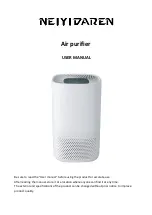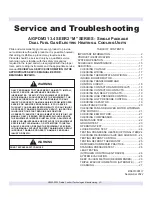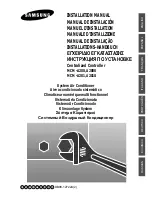
3
Same tube sizes are capable of handling higher flowrates
(expressed as tons of cooling capacity) with Puron
refrigerant compared to R--22 at constant pressure drops.
For example, a
1
/
2
--inch OD liquid line is rated at 33%
higher tons with Puron
R
than with R--22 (at 5
_
F pressure
drop). A 1
1
/
8
--inch OD suction line is rated at 53% higher
tons with Puron than with R--22 (at 2
_
F pressure drop).
Refrigeration lines selected for R--22 use are typically
oversized for Puron applications. Carefully check the
existing suction line size against the table for maximum size
(see Table 8); replace vertical riser segments if necessary.
Check existing liquid line size against sizing data in Table 5
or 6; replace with smaller lines when feasible.
Installation –
1. Remove the existing evaporator coil or fan coil and
install the replacement coil when appropriate.
2. Drain oil from low points and traps in suction line
tubing (and hot gas bypass tubing if appropriate) and
evaporator if they were not replaced. Removing oil
from evaporator coil may require purging of the
tubing with dry nitrogen.
3. Unless indoor unit is equipped with a Puron
approved metering device, change the metering
device to a thermal expansion valve (TXV) designed
for Puron
R
(R-410A).
4. Remove the existing outdoor unit. Install the new out-
door unit according to these installation instructions.
5. Install a new field-supplied liquid-line filter drier at
the indoor coil just upstream of the TXV or fix orifice
metering device.
6. If a suction line filter drier is also to be installed, in-
stall suction line drier downstream of suction line ser-
vice valve at condensing unit.
UNIT DAMAGE HAZARD
Failure to follow this caution may result in equipment
damage or improper operation.
Never install suction--line filter drier in the liquid--line
of a Puron
R
system.
CAUTION
!
7. If required, install a 100% activated alumina suction
line filter drier at the outdoor unit.
8. Evacuate and charge the system according to the in-
structions in this installation manual.
9. Operate the system for 10 hr. Monitor the pressure
drop across the suction line filter drier. If pressure
drop exceeds 3 psig (21kPa), replace suction-line and
liquid-line filter driers. Be sure to purge system with
dry nitrogen and evacuate when replacing filter
driers. Continue to monitor the pressure drop across
suction-line filter drier. Repeat filter changes if neces-
sary. Never leave suction-line filter drier in system
longer than 72 hr (actual time).
Rated Indoor Airflow (cfm)
The table below lists the rated indoor airflow used for the
AHRI efficiency rating for the units covered in this
document.
569J***A/B/G/H with 524J***A
Model Numbers
Full Load Airflow (cfm)
569J*07A/B --- 524J*07A
2400
569J*07G/H --- 524J*07A
2625
569J*08A/B --- 524J*08A
3000
569J*12A/B --- 524J*12A
4000
569J*14A/B --- 524J*14A
4375
569J***D/E/F with 524J***A
Model Numbers
Full Load Airflow (cfm)
569J*12D/E/F --- 524J*12A
4000
569J*14D/E --- 524J*14A
4400
569J
Summary of Contents for 569J Series
Page 34: ...34 C10925 Fig 29 Typical Single Circuit Single Stage 569J A B Wiring Diagram 569J ...
Page 35: ...35 C150339 Fig 30 Typical Single Circuit Two Stage 569J 07G H Wiring Diagram 569J ...
Page 36: ...36 C12547 Fig 31 Typical Dual Circuit Two Stage 569J D E F Wiring Diagram 569J ...
Page 53: ...53 D K J H G F E C B A C10800 Fig 44 Wind Baffles 569J ...




































